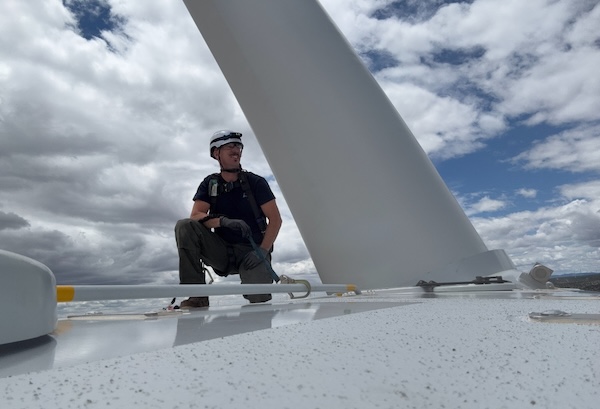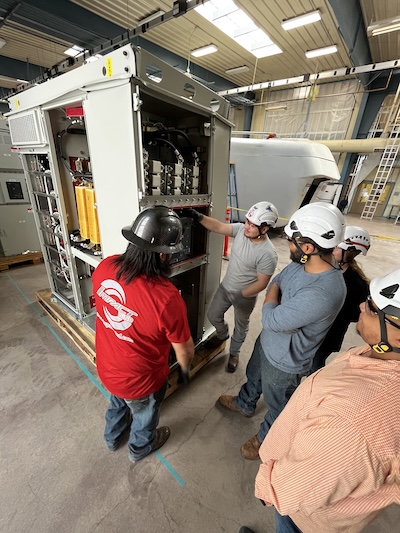The Real Power Behind the Turbines: Workforce at a crossroads
There’s a quiet shift happening on wind farms across the country — not in the turbines themselves, but in the boots on the ground. As the wind industry expands to meet energy goals and climate commitments, our biggest asset isn’t just clean air or wide-open land. It’s people.
Technicians, logistics coordinators, site managers, safety professionals, and support staff — these are the hands that build, maintain, and operate every tower on the skyline. But our workforce is approaching a critical inflection point; as demand for renewable energy grows, so does the pressure to attract and retain skilled labor. That challenge is already shaping the future of our industry.

More than the climb
From the outside, a wind technician’s job might look like a thrill-seeker’s dream: climbing hundreds of feet into the air, traveling to remote locations, working with heavy-duty tools. But for those of us on the inside, it’s clear that wind work is as demanding as it is exhilarating.
Technicians face long hours, extreme weather, and isolation from family and friends. That’s why strong onboarding, realistic expectations, and continuous support are essential; not only to keep people safe, but to keep them in the field.
Retention starts with respect. It’s not just about offering competitive wages. It’s about creating clear career pathways, offering consistent feedback, and including techs in decisions that impact their daily work. The best technicians are not only trained, they’re trusted.
Culture is the new currency
Today’s workforce, especially younger generations, isn’t just chasing paychecks. They want purpose, flexibility, and a sense of belonging. The companies that thrive are those that prioritize culture as much as compensation. That means normalizing things like mental health support, work-life balance, and open communication between field and office teams. When workers feel heard and valued, loyalty follows. When they don’t, they leave.
We must stop treating technicians as interchangeable parts in a machine. They are skilled, adaptable professionals who often identify issues before engineers do. They are the backbone of this industry, and they deserve to be seen and treated that way.
 Diversity isn’t a buzzword
Diversity isn’t a buzzword
The wind industry is full of opportunity, but we’ve struggled to fully open the door to everyone who could thrive here. If we want to solve workforce shortages and build long-term strength, we need to reach a wider range of people, especially those who may not have traditionally seen a place for themselves in this field. That starts with visibility and access: outreach to high schools, trade programs, and community colleges; building real-world internships; and showing what a career in wind can offer. We also need to break down practical barriers like transportation, training costs, or lack of industry connections — anything that prevents capable individuals from entering or advancing in the industry.
If we want to harness the full power of the wind, we need a workforce as adaptable and forward-thinking as the technology itself. That means welcoming people from different life paths, skill sets, and perspectives, and giving them room to grow.
Looking ahead
We can’t build the future of energy on outdated workforce models. This moment calls for real investment — not just in turbines and infrastructure, but in people. That means mentorship, career development, and honest conversations about burnout and retention.
It’s time to ask bigger questions. Not just “How many turbines can we build?” but “How many lives can we improve in the process?” Instead of asking, “How fast can we grow?” we should ask, “How well are we supporting the people who make that growth possible?”
The wind industry has always been about transformation. Now, we have a chance to transform not just our energy system, but the way we treat the people powering it.
Jon Bishop is a partner at Impact Wind, a workforce-centered company committed to supporting wind technicians and field teams across North America. With a background in operations, HR, and site logistics, Jon focuses on creating sustainable careers in the renewable energy sector. He also helps lead the Impact Wind Training Center, a GWO-certified facility in Tucumcari, NM, dedicated to advancing the safety and technical skills of wind professionals. Impact Wind is a privately owned company with over 30 years of combined industry experience, focusing on delivering skilled manpower for Operations & Maintenance (O&M) and Repower services across the U.S. Impact Wind is deeply committed to the growth and development of wind professionals. Owning and operating our GWO-certified training center in Tucumcari, New Mexico, lets us prepare new and experienced technicians with the practical, hands-on skills needed to succeed in the field. Our team is made up of people who’ve worked in the towers, managed the sites, and supported crews through every kind of challenge. We’re proud to be building a stronger, safer, and more sustainable wind workforce for the future.
Impact Wind | www.impactwind.com
Email: [email protected]
Author: Jon Bishop
Volume: 2025 July/August










